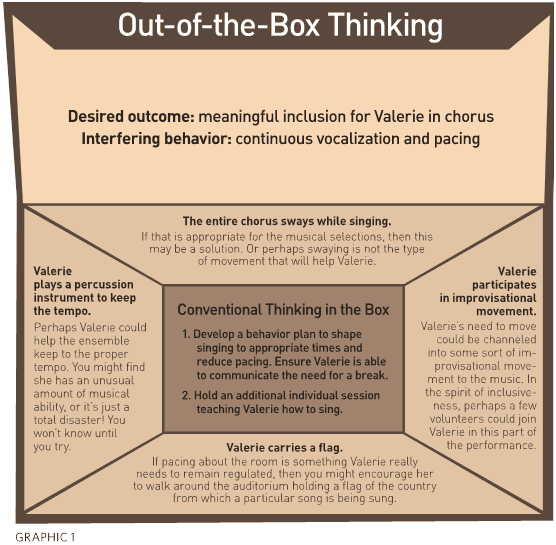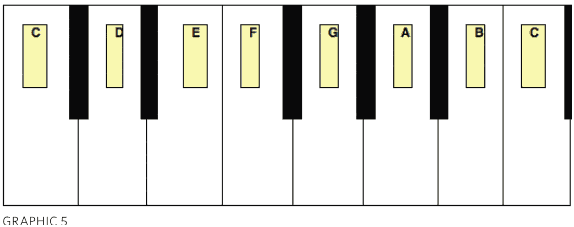 |
 |
 |
||
|
|
|
|||
|
WritingsTrue
Inclusion through Music
Stephen Shore, EdD Shore,
S., (2013). True Inclusion though Music. Autism Asperger's
Digest. May-June 2013. P. 36-39
There are many ways to meaningfully
include There are myriad reasons for everyone- whether on the spectrum or not-to engage in music. It provides a greater understanding of the human condition and engenders therapeutic benefits in areas such as communication, social interaction, and motor control. Furthermore, music can become an area of competence, which is especially important for individuals challenged in traditional academics and social interaction. Individuals on all parts of the spectrum can engage in music to some extent. The students I teach musical instruments to range from preverbal with significant challenges to those with Asperger's Syndrome. Often individuals with autism spectrum disorder (ASD) can perform at or above the level of their typically developing peers in music. Efforts for developing inclusion strategies for students with ASD in music can be challenging. The good news is that tools already exist for modifying curriculum, giving individuals with ASD an equal chance for success in their education. It's just a matter of implementation. Depending on the student's ability to participate, accommodations may be developed to level the playing field. On the other hand, some students- no matter what adjustments are made to the curriculum-remain unable to participate in exactly the same way as their classmates. However, modification can still be made where the student remains meaningfully included with typical peers, benefitting all involved. Including Valerie in Chorus Valerie is also a pacer. While she does not try to escape the room, she does need to walk-making it impossible for her to remain still with her section. The music director is deeply concerned about how this behavior will affect the remaining rehearsals and the upcoming concert showcasing international music. Valerie's current behaviors suggest that she is unable to participate in chorus in the same way as her classmates. In the spirit of meaningful inclusion, how can Valerie be involved so that both she and typical students benefit from the situation? Given Valerie's propensity for continuous (and disruptive) vocalizations, how can she be taught to sing with her section, on pitch, and with good intonation?
Often educators restrict themselves and their students by focusing on weak- nesses and difficulties a student may be experiencing. Getting out of this trap requires thinking outside of the proverbial box by expanding the concept of how Valerie can contribute and participate in rehearsals and performances. Looking at what Valerie can do may provide the key. A Possible Explanation. A characteristic of ASD that is finally being recognized in the upcoming Diagnostic and Statistical Manual of Mental Disorders 5 (DSM-V) is the presence of sensory issues in individuals with ASD. With some of the sensory receptors being turned up "too high" and others "too low," combined with the distortion of what is received, many individuals with ASD have greater difficulty regulating their sensory systems. Whereas shaking one's foot, doodling, or playing with one's hair while seated at a lecture are common self-regulatory actions most people will take, those with ASD tend to be more dysregulated, and their attempts to regulate the sensory system will be greater. Self-regulatory behaviors can include flapping, vocalization, and pacing. You notice that when Valerie is pacing, she quiets down. This suggests a possible link to self-regulation. If Valerie has a need to move for regulatory reasons, perhaps there's a way to employ this behavior to include her in choral activities. Employing the Need to Move. If singing is not a possibility at this time, it's important to work with what Valerie can do. It appears Valerie needs to move, and there are many creative ways to incorporate movement into a choral performance. Out-of-the-Box Thinking. Graphic 1 shows some examples of how an individual with ASD can be included in a musical activity. It's possible that one or some of the modifications will work, or the music director will have to think of another strategy. Valerie may not be doing the same thing as her class- mates; however, she still meaning- fully contributes to the performance benefitting the ensemble, the audience, and herself-in her own way. Teaching Sam the Piano I have found that collaborating with the student to develop the necessary supporting aids for learning to play his first musical instrument makes the use of these materials more meaningful to him. The following are steps I take when first teaching a student with ASD how to play the piano.
Walking over, grabbing a pencil from my hand, Sam presses the pencil against the ruler, drawing a straight line lengthwise down the page. I turn the ruler 90 degrees. "How about three more lines going sideways " Done! A nice, early success. Soon we have a 2 x 4 inch matrix of 8 squares drawn on a piece of paper. Sam responds with "A!" when I ask him for the first letter of the alphabet. After having him write the letter in the first box, we go to letter B and finish up with G. The remaining box is designated as Extra. A break is taken if needed. Otherwise we launch into step 2.
Next, the child cuts the bottom off the sticky notes before cutting out each individual letter. Again, any necessary physical support is pro- vided to accommodate for potential fine-motor control challenges. My question "Where does the A go?" is answered
with Sam then pointing to the box with the corresponding letter
he previously wrote (see graphic 4). Soon, the entire paper
is filled with letters. Step 3: Exploring the Keyboard. Moving to the piano, Sam responds to my query as to what the first key on the left is called with a loud "A!" which is correct for a keyboard with 88 keys. (The note C starts off smaller 61-key keyboards.) After asking Sam to take a letter A from the bank, followed by placing it on the keyboard (see graphic 5), we move on to the other letters until the entire keyboard is notated. Like many with ASD, Sam excels at pattern recognition and has decoded the system after only three letters and rapidly finishes off the keyboard.
Now it's time to begin exploring the keyboard. For example, I might ask Sam to touch an A. Then I'll query Sam to find other notes such as C or F. Depending on the student's developmental level, I may ask him to tell me how many Es are on the keyboard. Perhaps after determining how many of various letters are on the keyboard, we may take note that there are eight of some notes and only seven of others. Similarly we'll explore how the black keys pat- tern themselves into groups of two and three. This is a great time to take a break if the student needs to. Others get so wrapped up in the activities and systems of music that we have only begun to explore that they may work the entire hour with the greatest challenge being to end the session in good order! Step 4: Learning about the Musical Staff and Treble Clef. After gaining familiarity with the keyboard, we go back to the table to draw a musical staff and a treble clef in the same manner that we created the notes bank. After getting to know the lines and spaces where the notes "live" and putting those yellow sticky notes on the staff, we go on to matching notes on the staff to the keys on the piano. Soon, the student is playing familiar melodies and is reading music without realizing it! We do additional work focusing on rhythm, time signatures, and note values at this point. Step 5: Transitioning to Introductory Piano Lessons. By this time, the student knows most of what is covered in the introductory piano book, which makes playing the piano friendly, familiar, and fun! Whether it's performing in a musical ensemble, learning to play a musical instrument, or even engaging in content from a music appreciation class, there are many ways to meaningfully include a child with ASD in the music curriculum. Some adaptations may include substantially changing how the student participates in a musical ensemble, such as the case with Valerie finding an alternate way of joining a choral performance. Other changes to curriculum might involve changes in modality of teaching a student and in how he can demonstrate mastery of knowledge or a technique. On a final note (no pun intended), I have yet to figure out how to teach music to children who are not on the spectrum. Those with ASD are so much more predictable and easier to understand! Nonverbal until four and recommended for institutionalization, Dr. Stephen Shore, now professor of special education at Adelphi University, focuses on helping people with autism develop their capacities to their fullest extent possible. Internationally known author, consultant, and presenter, Stephen serves on the boards of several autism-related organizations. For additional information, visit Stephen's website: www.autismasperger.net.
|
||||||||||||||||||||
|
Biography of Stephen Shore | Writings | Links | FAQ | Contact Stephen Shore | Home |
|||||||||||||||||||||





 Step
1: Naming the Musical Notes. (See graphic 2.) "Hey
Sam! Help me draw a straight line with this ruler."
Step
1: Naming the Musical Notes. (See graphic 2.) "Hey
Sam! Help me draw a straight line with this ruler."  Step
2: Making Deposits to the Letter Bank. (See graphic 3.)
Taking a sticky note prepared in advance, the student is instructed
to write a string of eight As across the top. The student's
fine-motor skills dictate whether I need to provide hand-over-hand
support, perhaps a hand on his wrist or arm for some stabilization,
or just provide verbal prompting. The amount of support is
customized to the student's needs. Soon, several sheets of
sticky notes are filled with letters from A though G. Note
that the sticky note is divided into eight sections because
eventually, those individual letters will be cut out and placed
right on the piano keyboard between the black notes.
Step
2: Making Deposits to the Letter Bank. (See graphic 3.)
Taking a sticky note prepared in advance, the student is instructed
to write a string of eight As across the top. The student's
fine-motor skills dictate whether I need to provide hand-over-hand
support, perhaps a hand on his wrist or arm for some stabilization,
or just provide verbal prompting. The amount of support is
customized to the student's needs. Soon, several sheets of
sticky notes are filled with letters from A though G. Note
that the sticky note is divided into eight sections because
eventually, those individual letters will be cut out and placed
right on the piano keyboard between the black notes.
